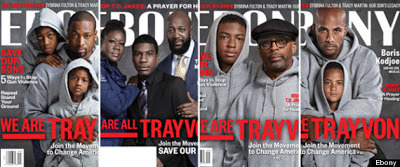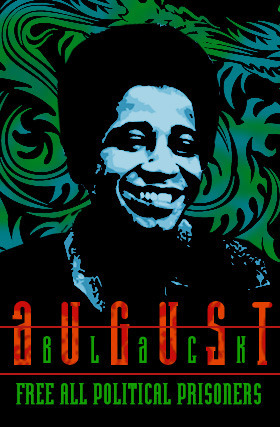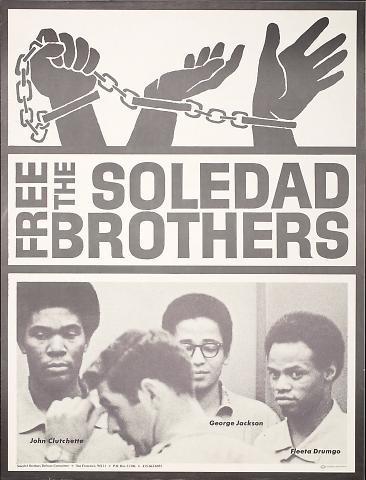Mark Anthony Neal's Blog, page 875
August 12, 2013
Bayard Rustin Awarded Presidential Medal of Freedom on Eve of 50th Anniversary of the March on Washington
 Democracy Now
Democracy NowThe White House has announced it will posthumously award the highest civilian award in the United States, the Presidential Medal of Freedom, to the trailblazing civil rights activist Bayard Rustin. Obama will honor Rustin and 15 others including President Bill Clinton, Oprah Winfrey and baseball great Ernie Banks at the White House later this year.
Rustin was a key advisor to Martin Luther King Jr. and introduced him to Mahatma Gandhi's teachings on nonviolence. Rustin helped King start the Southern Christian Leadership Conference in 1957. Six years later, he was the chief organizer of the historic 1963 March on Washington for Jobs and Freedom, rallying hundreds of thousands of people for economic justice, full employment, voting rights and equal opportunity. "Rustin was one of the most important social justice activists in the U.S. in the 20th century," says John D'Emilio, author of "Lost Prophet: The Life and Times of Bayard Rustin," "Rustin pioneered the use of Gandhian nonviolence as a way of calling attention to segregation and other forms of racism in the United States." We also speak to former NAACP chair Julian Bond and Rustin's partner, Walter Naegle.
Published on August 12, 2013 17:24
'We Are Trayvon Martin": HuffPost Live Unpacks Ebony Magazine's September Issue

For its September issue, Ebony Magazine chose not one, but four covers to open the conversation about race in America. HuffPost Live talks with the magazine's editor to discuss the Trayvon Martin case, race relations, and "Stand Your Ground."
Hosted by: · Marc Lamont Hill
Guests:· Amy DuBois Barnett @amydbarnett (Chicago, IL) Ebony Magazine Editor-In-Chief· Mark Anthony Neal @NewBlackMan (Durham, NC) Professor of Black Popular Culture at Duke University · Michael Eric Dyson @MichaelEDyson (Washington, DC) Professor of Sociology at Georgetown University
Published on August 12, 2013 11:37
August 11, 2013
'Black August' Celebration Honors Freedom Fighters by Lamont Lilly

‘Black August’ Celebration Honors Freedom Fighters by Lamont Lilly | special to NewBlackMan (in Exile)
On August 28th1963, the March on Washington for Jobs and Freedom galvanized hundreds of thousands in the streets of the nation’s capital. On August 25th1925, A. Philip Randolph helped to establish the Brotherhood of Sleeping Car Porters in Harlem, NY. It was in August 1791 that the Haitian Revolution first broke the chains of French colonialism. August marks the Nat Turner Rebellion of 1831 and Watts Uprising of 1965. It was on August 8th 1978 that the Philadelphia Police Department first raided the MOVE Organization, giving way to the MOVE 9. August also bears the births of Fred Hampton, Marcus Garvey and Mutulu Shakur. Ironically, August has always been a month of Black struggle and radical resistance.
Black August is a month-long celebration that marks the remembrance of the lives of freedom fighters who gave their all for black liberation, freedom and mass consciousness. The origin of Black August was first initiated in honor of the fallen soldiers who valiantly fought to liberate George Lester Jackson from the modern day slave trade we now call the U.S. penal system.
On August 7th1970, freedom fighters – James McClain, William Christmas, Ruchell Magee, Khatari Gaulden and 17 year old Jonathan Jackson led a courthouse rebellion in a brave display of all-out resistance and armed struggle. Unfortunately, lives were lost as they typically are in any war. Magee, who is currently still incarcerated, was the only survivor. And though our heralded comrade, George Jackson was not completely freed, the efforts of Jonathan and others would inspire decades of continued resistance and revolutionary solidarity.

In 1970, George Jackson had just completed Soledad Brother, a philosophical revolutionary classic. Jackson however, was assassinated by San Quentin prison guards one year later on August 21st1971. His second book, Blood in My Eyewas published posthumously by Black Classic Press. Jackson’s legacy has inspired millions worldwide, while his literary works continue to teach even in his physical absence. This is the background in which Black August was first formed. It was deep within the belly of the California Penal System that it was first embraced and formally established as a month of reverence, as a time of revolutionary celebration.
Inmates today have continued to protest and press forward all over the United States. Hunger strikes have roused hundreds of thousands in states such as California, Georgia and North Carolina. Letter writing campaigns have served as vital lines of inspiration and direct communication. Human Rights activists such as Mumia Abu-Jamal have served as critical catalysts, tirelessly working to empower the voices of those who continue to be oppressed by the public and private prison industry.
Today, in the spirit of continued resistance we honor the deaths of Mark Clark, Fred Hampton and Geronimo Pratt. We honor the sacrifices and life work of political prisoners, Eddie Conway, Assata Shakur and Sundiata Acoli. We honor the countless victims of COINTELPRO’s callous attacks upon the people. We duly recognize the destructive ills of capitalism and its disastrous effects upon the oppressed, worldwide. In the age of the prison industrial complex, school to prison pipeline and widespread police brutality, the struggle for justice and liberation is alive now more than ever.

In the 34thyear of Black August, may we all take heed to the spirited words of our brother and mentor, George Lester Jackson: “Settle your quarrels, come together, understand the reality of our situation, understand that fascism is already here, that people are dying who could be saved.”
***
Durham activist, Lamont Lilly is a contributing editor with the Triangle Free Press, Human Rights Delegate with Witness for Peace and organizer with Workers World Party. Follow him on Twitter @LamontLilly.
Published on August 11, 2013 20:22
Farm to Table Family: Roast Chicken with Summer Vegetables
 Farm to Table Family | PBS Parents
Farm to Table Family | PBS ParentsRoast Chicken is one of our family's favorite meals. This recipe makes tender juicy chicken with crispy skin! It a perfect one pot meal that is so easy and delicious and a favorite of ours year round.
RECIPE
Secret to juicy chicken: Marinate chicken in milk and sliced apples overnight to tenderize the meat.
Steps:1. Wash the chicken well, pat it super dry for crispy skin. 2. Prepare some favorite vegetables to cook with the chicken. Onions, potatoes, carrots, and leeks are a good mix. Try to cut the vegetables the same size to help them cook evenly. 3. Preheat the oven to 450F.4. Coat the chicken in grapeseed or olive oil. About 3 tablespoons.5. Generously salt and pepper the chicken all over.6. Add fresh herbs (rosemary, sage, or thyme), garlic, salt, and pepper inside.7. Tuck in the wings.8. Optional: truss the chicken.9. Place the vegetables in the roasting pan and add enough oil to lightly coat them. About 3 tablespoons. 10. Generously season with salt and pepper and add fresh thyme. Toss the vegetables.11. Place the chicken on top of the vegetables.12. Place 4 tablespoons of butter on top of the chicken. 13. Cook in the oven at 450F for 1 hr or until skin is crispy and brown.
Published on August 11, 2013 20:00
'Dropping Science': Profile of the Science Genius Program
 NPR
NPRThe Science Genius program is bringing hip-hop into the classroom and challenging students at nine New York City public high schools to rap about science.
Finalists from each school faced off at the Science Genius B.A.T.T.L.E.S. (Bring Attention to Transforming Teaching, Learning and Engagement in Science) competition earlier this summer.
Published on August 11, 2013 13:45
August 10, 2013
Beat Making Lab: Heartbeats of Fiji (Ep. 1 of 5)
 Beat Making Lab | PBS Digital Studios
Beat Making Lab | PBS Digital StudiosBen is searching for purpose. Masi is following a dream. From separate islands, yet connected through Hip Hop and Electronic music production, their paths crossed at the Fiji Beat Making Lab.
Filmmaker: Jon Kasbe
Music: Ben Morrison, Masi Rova (E3), Apple Juice Kid, Fiji Beat Making Lab
Filmed at: Oceania Centre for Arts, Culture and Pacific Studies at The University of the South Pacific
Thanks: Dave Lavaki (aka Mr. Grin), Dana McMahan, Judith Cone, Dr. Mark Katz, Fiji Beat Making Lab, Pierce Freelon, Saleem Reshamwala, Apple Juice Kid, US Embassy of Fiji
Published on August 10, 2013 16:27
MHP Show: How Reporting Helped Shape the Civil Rights Movement
Published on August 10, 2013 13:00
From HS Dropout and Pregnant...and on to College

State of the Re-Union
In this episode, SOTRU travels to Holyoke, Massachusetts, home of the Care Center. an alternative school just for pregnant and parenting teens who’ve dropped out of high school. It’s not your typical GED program, either: it’s modeled on a prep school, so students are learning fencing, rowing, yoga and poetry along with basic math and reading. Their personal histories are fraught with homelessness, domestic violence, gangs, food insecurity—the entire student body is living at or below 50% of the poverty level, and 2/3rds of them dropped out of high school by the 10th grade. Despite all that, between 70 and 85 percent of Care Center students go on to college. In this American Graduate special, State of the Re:Union goes deep inside this school—learning its philosophy and the life stories of students and teachers—to explore what it takes to turn a teen mom’s life around.
Published on August 10, 2013 12:06
“Picasso Baby”: Hip-Hop and the Appropriation of Space
 with Mickaline Thomas
“Picasso Baby”: Hip-Hop and the Appropriation of Space
with Mickaline Thomas
“Picasso Baby”: Hip-Hop and the Appropriation of Space
by Mark Anthony Neal | NewBlackMan (in Exile)
The most conventional way to think about Hip-Hop culture, particularly rap music, is to think of it as the structure that has given generations of youth (largely Black and Brown, but no longer exclusively so) a voice to project myriad fears, desires, angers and joys into a world that has little interest in any of it—unless it impacts the bottom line.
Yet from the very beginning Hip-hop was about a politics of space—from the ways that that first generation was socialized by a State logic that rendered them (and their communities) inconsequential, thus subject to all manner to removal, relocation and dislocation, to the buildings, and subways and other public works that they “bombed” in order to reorient a built environment more interested in interstate travel than their lives, to Kool Herc and Cindy Campbell’s simple desire to have a space where the young folk could convene. Wherever Hip-Hop has gone, it has fundamentally changed the space.
Jay Z’s recent film short, Picasso Baby: A Performance Art Film , directed by Mark Romanek, who also shot Mr. Carter’s “99 Problems,” is a reminder of those politics of space as it relates not only to Hip-Hop but the encroachment of Black bodies—of the actual and rendered kind—into spaces that remain defined by privilege, whiteness and White Privilege. Jay Z’s entrance into Pace Gallery recalls a scene nearly thirty years earlier, when three young Black men, clad in black leather jackets and black brims, proclaiming themselves the "King(s) of Rock," walked into another museum and are told “you guys don’t belong here.”
 Just as Run-DMC was breaking down commercial barriers—MTV then as resistant to Black bodies as any high end art gallery—Jean Michel Basquiat was breaking down barriers in the art world. Though Picasso is the signifier that brings every one together—and to our worse fears about Picasso and appropriation, Mr. Carter is here appropriating, dare I say colonizing, space— it is Basquiat who clearly haunts this space.
Just as Run-DMC was breaking down commercial barriers—MTV then as resistant to Black bodies as any high end art gallery—Jean Michel Basquiat was breaking down barriers in the art world. Though Picasso is the signifier that brings every one together—and to our worse fears about Picasso and appropriation, Mr. Carter is here appropriating, dare I say colonizing, space— it is Basquiat who clearly haunts this space. Since Jean Michel can’t be in the room (though he makes rhetorical appearances), we are provided with his people—the legendary graff artist Fab Five Freddy, Lorna Simpson, Mickaline Thomas, Wangechi Mutu (whose Trevor Schoonmaker curated exhibit A Fantastic Journey opens at the Brooklyn Museum in October) and Kehinde Wiley, to name just a few; Black artists who can imagine making a living in the world of high brow art without having to traffic in trinkets of tokenism (what Thelma Golden was trying to explode a generation ago with her notion of the post-Black) or the guilt of having to be too authentic for audiences who know no better.
Direct inspiration for “Picasso Baby” can be traced to performance artist Marina Abramović and her 2010 installation “The Artist is Present” (MoMA), though Jay Z also draws from other conceptual sources, notably Fred Wilson.Pace Galley represents Wilson, who shows up frequently in the early stages of “Picasso Baby.” The Bronx born Wilson, a sculptor by training, came to prominence in the late 1980s with his installation “Room with a View” and later “Mining the Museum” in which he used the Maryland Historical Society’s collections to highlight a history of enslavement in the United States. Much of Wilson’s art in recent years has literally been about re-purposing museum spaces. As Kellie Jones writes of Wilson in her book EyeMinded: Living and Writing Contemporary Art, “he began to blur the lines between curator and artist and move toward an art practice that would take as its central force the explosion of antediluvian museum frameworks…Wilson addressed not only viewers but also people working inside such cultural institutions.” (13) True to Hip-Hop’s signature conceit, Jay Z is trying to alter the space.

As Nasher Museum curator Trevor Schoonmaker notes of Wilson’s presence in the “Picasso Baby” film short, “No one would bat an eye if say, Yasiin Bey (Mos Def) and Fred were in the same room. Nor Kehinde and Jay-Z (which of course we just saw)., but Fred and Jay Z? And while Pace Gallery does represent Fred, Jay-Z and his video editor/director clearly strategically highlighted Fred Wilson at the beginning, middle and end of the video. Many artists are more famous than Fred, but few are more respected for the integrity of their critical work. Purely strategic association.” Schoonmaker adds, “it's a brilliant move for [Jay Z] to align himself with a group of socially conscious and politically dedicated visual artists. Not to mention the editing makes them look like any other fans of his.”
One of the difficult realities when a celebrity of Jay Z’s status inhabits such an elite space—even as he duly acknowledges Black working artists who are perhaps equally famous in their own realms—is that it can overshadow those artists who have been…doing the work. Such might be the case with Atlanta-based artist Fahamu Pecou, whose recent installation All Dat Glitters Aint Goals —a visual meditation on the relationship between Hip-Hop and Black Masculinity—literally brings those images to life via a series of music videosand recordings. As Pecou tells Creative Loafing’s Rodney Carmichael, “So this first body of work is All Dat Glitters Aint Goals, and it's really kind of playing with the perception and oftentimes the constructs that you see these rappers have, which are not really indicative of who they truly are. These are characters that they create to sell records. But to people on the outside looking in, there's no suspension of disbelief.”
Though their level of execution is different—Pecou is a working visual artist has been fighting the good fight to have a presence in these spaces his whole career, while Jay Z is a pop star (with artistic sensibilities) whose social capital allows him to ”buy” himself into these spaces—their commitment to transforming the space is what aligns them. When you see Picasso Baby: A Performance Art Film, you see a room full of people that you might not expect to see at an art gallery—some of them even famous like Taraji P. Henson or Rosie Perez or Wale.
What makes Jay Z’s intervention here important, is not the art per se, but the people he can bring to the space. This is not lost of Pecou: “Regardless of where in the world I do an exhibition, there generally tends to be anywhere from a dozen to a half a dozen people who come in and are like, 'Man I never been in an art gallery before. I didn't know this was art; I get this." I get that on a very small level every time I do a project so I've been trying to figure out ways to create more meaningful, impactful engagements for people who don't necessarily frequent the art gallery, but can appreciate this and have a dialogue about this and really get something from it.”
***
Mark Anthony Neal is Professor of African & African American Studies at Duke University and the author of several books, including the recent Looking for Leroy: Illegible Black Masculinities (NYU Press). This fall Neal will be a Fellow at the Hiphop Archives at the W.E.B. DuBois Institute at Harvard University. Follow him on Twitter: @NewBlackMan
Published on August 10, 2013 05:56
August 9, 2013
Lee Daniels: 'The Butler' is "Not a Movie, It's a Movement"
Published on August 09, 2013 11:48
Mark Anthony Neal's Blog
- Mark Anthony Neal's profile
- 30 followers
Mark Anthony Neal isn't a Goodreads Author
(yet),
but they
do have a blog,
so here are some recent posts imported from
their feed.





